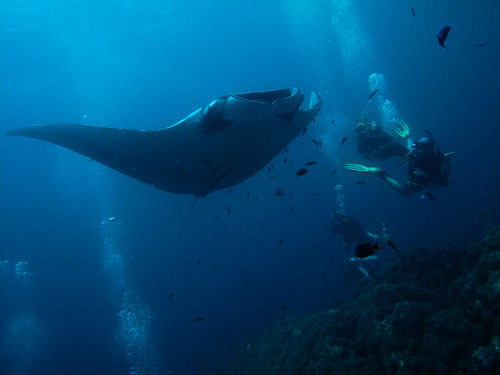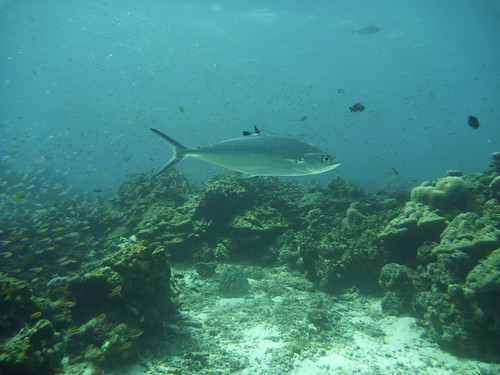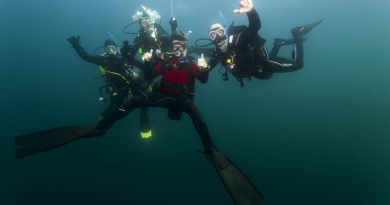Guest Post: Thailand: A Divers Paradise
This is a first: a guest post on Pacificklaus.com! Thanks to Oscar Waterworth (oscar.waterworth@gmail.com) for contributing!
Diving in Thailand: How is that? In the few days I spent in Thailand, the country struck me as a place of magnificent temples, amazing food (if you like it spicy!), and gorgeous women. I didn’t make it underwater, though. Is it worth diving there? I have heard mixed reviews. But Oscar definitely thinks so!
Thailand is definitely one of the “must dive” destinations. It is good for both beginners and advanced divers, and in its depths you can see lots of tropical fishes, reef dwelers and underwater Kodak-moments. Peak of Thailand’s diving season is from November to April, but the season itself lasts whole year round. Depending on the month you can see different kinds of sea creatures. Best time to see whale-sharks for example is from February to May, when there’s a higher concentration of plankton. Although Thailand has an all-year-round diving season it largely depends on surface conditions, and from May to October, there’s a lot of rain on the West coast. Another important parameter when it comes to diving in Thailand is the plankton density, which drastically increases in May, this reduces the visibility, but at the same time it brings the biggest plankton-eating sea creatures out on the open. These are some of the best places to dive in Thailand.
Similian Islands
This is one of the most popular diving destinations in the country and there are many liveboards to rent. These islands are located in Andaman Sea, inside the protected national park area. Here, divers can watch some of the most beautiful tropical species including: black tip reef sharks, moray eels, snappers, barracudas, triggerfish, surgeonfish, leopard sharks and many more. On the Eastern side of the islands there are several coral reefs, while elsewhere you can find solid granite boulders laying on the sandy sea floor. Another popular diving spot is the Elephant Head Rock, which has a lot of holes where turtles, reef sharks and groupers are usually hiding.

Hin Daeng and Hin Muang
If you are looking for manta rays and whale-sharks these two underwater rocks are the best places to be. Accept these two species you can also find plenty other reef fish hiding inside the colorful soft corals. Here you can also spot barracudas, reef sharks, trevallies and many other fishes. Hin Muang rock is a little bit more difficult to dive, since it increases the current speed over the upper surface. Hin Daeng on the other hand is easier and it features some of the brightest red soft corals and a lot of action that goes around them.

Koh Lipe
At Koh Lipe and its twelve surrounding islands you can find several reefs with both soft and hard corals. These reefs are inhabited with lots of fish species, some of them are: angel fish, surgeon fish, butterfly fish, batfish, parrot fish etc. If you enjoyed Finding Nemo, you will be happy to hear that near these reefs you can find a lot of clown fishes as well. From bigger species there are: barracudas, trevalliers and fusiliers. Next door to all these fish species you can find lots of reef dwellers like seahorses, cuttlefish and crabs and some bigger sea creatures like sharks, turtles and devil and mango rays. All this maritime life combined with stunning island flora makes Ko Lipe diving experience on of the best in the whole of South East Asia.
Richelieu Rock
This site is very attractive for scuba divers, especially because it is relatively close to some of the most popular tourist spots in Thailand like Phuket and Khao Lak. From fish species here you can see barracuda, trevally, and there are also some groupers and snappers. This rock is covered with colorful red soft corals, with lot of small holes and caves that are full of life and host many reef dweller species. This is also one of the best places to see whale-sharks since the sea around the Richelieu Rock is very nutrient and in the plankton season here you can see a lot of these stunning creatures.
Thailand is definitely one of the best places to dive on the planet. Accept all the tropical maritime life and colorful coral reef, this country also offers great value for money when it comes to organized liveboard dives. All this makes divers come back to the “Land of Smiles” every year, so they can explore these magnificent waters a little bit more.


